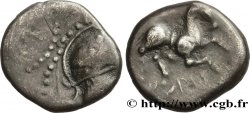bga_1054471 - EDUENS, ÆDUI (BIBRACTE, Area of the Mont-Beuvray) Denier LVCIOS, revers à l’esse
600.00 €(Approx. 696.00$ | 528.00£)
Quantity
Add to your cart

Type : Denier LVCIOS, revers à l’esse
Date: c. 60-50 AC.
Mint name / Town : Autun (71)
Metal : silver
Diameter : 12,5 mm
Orientation dies : 5 h.
Weight : 1,76 g.
Rarity : R3
Coments on the condition:
Flan court et centré. Des faiblesses et une usure régulière. Patine grise
Catalogue references :
Obverse
Obverse legend : [LVCIOS].
Obverse description : Buste féminin diadémé à gauche, un croissant dans la chevelure ; grènetis.
Reverse
Reverse legend : LVCIOS.
Reverse description : Guerrier gaulois debout de face, vêtu militairement, tenant de la main droite un sanglier enseigne et de la main gauche un bouclier oblong ; grènetis.
Commentary
Typologiquement, ce denier se distingue des deniers DVBNOCOV et VIIPOTAL uniquement par le croissant dans la chevelure au droit (qui permettrait d’identifier la déesse Diane), et par la légende LVCIOS au droit comme au revers.
Notre exemplaire se distingue des rares exemplaires publiés par la présence d’une esse entre le guerrier et le bouclier. Au droit, derrière la nuque, on observe une trace de motif incus ; il s’agit du bout de l’enseigne du revers.
L’attribution ancienne aux Pictons, désormais abandonnée, ne reposait que “sur le fait qu’un exemplaire de ce type se trouvait dans le trésor de Vernon, parmi un millier de deniers romains et plusieurs centaines de quinaires de la zone du denier”.
Dans le RIG, B. Fischer précise que Serrure attribua cette monnaie au chef Liscus, vergobret des Éduens. Une autre attribution aux Petrocores repose sur l’identité de la légende avec le bronze LVCCIOS (qui n’a pourtant rien à voir)..
Typologically, this denarius differs from the DVBNOCOV and VIIPOTAL denarii only by the crescent in the hair on the obverse (which would allow the identification of the goddess Diana), and by the legend LVCIOS on both the obverse and reverse. Our example differs from the rare published examples by the presence of an esse between the warrior and the shield. On the obverse, behind the neck, there is a trace of an incus motif; this is the end of the reverse ensign. The old attribution to the Pictons, now abandoned, was based only “on the fact that a example of this type was found in the Vernon treasure, among a thousand Roman denarii and several hundred quinarii from the denarius area”. In the RIG, B. Fischer specifies that Serrure attributed this coin to the chief Liscus, vergobret of the Aedui. Another attribution to the Petrocores is based on the identity of the legend with the bronze LVCCIOS (which, however, has nothing to do with it).
Notre exemplaire se distingue des rares exemplaires publiés par la présence d’une esse entre le guerrier et le bouclier. Au droit, derrière la nuque, on observe une trace de motif incus ; il s’agit du bout de l’enseigne du revers.
L’attribution ancienne aux Pictons, désormais abandonnée, ne reposait que “sur le fait qu’un exemplaire de ce type se trouvait dans le trésor de Vernon, parmi un millier de deniers romains et plusieurs centaines de quinaires de la zone du denier”.
Dans le RIG, B. Fischer précise que Serrure attribua cette monnaie au chef Liscus, vergobret des Éduens. Une autre attribution aux Petrocores repose sur l’identité de la légende avec le bronze LVCCIOS (qui n’a pourtant rien à voir)..
Typologically, this denarius differs from the DVBNOCOV and VIIPOTAL denarii only by the crescent in the hair on the obverse (which would allow the identification of the goddess Diana), and by the legend LVCIOS on both the obverse and reverse. Our example differs from the rare published examples by the presence of an esse between the warrior and the shield. On the obverse, behind the neck, there is a trace of an incus motif; this is the end of the reverse ensign. The old attribution to the Pictons, now abandoned, was based only “on the fact that a example of this type was found in the Vernon treasure, among a thousand Roman denarii and several hundred quinarii from the denarius area”. In the RIG, B. Fischer specifies that Serrure attributed this coin to the chief Liscus, vergobret of the Aedui. Another attribution to the Petrocores is based on the identity of the legend with the bronze LVCCIOS (which, however, has nothing to do with it).








 Report a mistake
Report a mistake Print the page
Print the page Share my selection
Share my selection Ask a question
Ask a question Consign / sell
Consign / sell
 Full data
Full data









